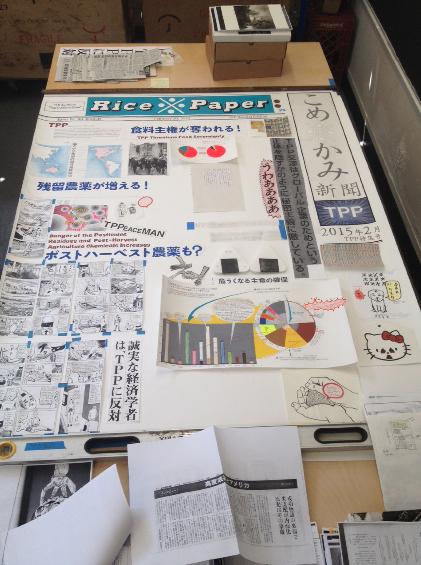
The Japan Times | 2 September 2015
Poster woman for the war against the U.S.-led TPP
Winifred Bird
For Yoko Inoue, art is like a bomb: Throw it into a crowded street and the truth just might explode out of it.
The Japanese-born, New York-based multimedia and performance artist takes aim at society’s assumptions about commerce and culture using works rooted in intensive research. This time, her target is the Trans-Pacific Partnership (TPP).
Inoue has been at work since February of this year on a project she calls “Rice Paper” (“Kome Kami”), a wall-mounted bilingual newspaper addressing the trade agreement currently being negotiated by 12 Pacific Rim nations, including Japan and the United States. The deal would reduce tariffs on goods such as rice, cars and beef, and alter other policies to encourage international trade. Despite lagging negotiations and stiff opposition from Japanese farmers and other stakeholders, it remains a priority for both U.S. President Barack Obama and Prime Minister Shinzo Abe.
Inoue, however, is convinced the TPP would harm Japanese society.
“Who benefits?” the 51-year-old artist asks on a recent afternoon in her neatly organized New York studio. “It’s the 1 percent who control all the policies and trade. Maybe we (in the general public) don’t realize it — but the corporations who want to benefit from the agreement are very tenaciously and meticulously planning everything possible to dismantle socio-economic structures. When we start paying attention, we say ‘Oh my God.’ ”
She hopes to get more people talking about the controversial deal through a series of handmade posters, which she plans to display in public places in Japan and the United States. The first 1×1.5-meter prototype is spread out on a table in her studio, beneath the sorrowful gaze of 10 oversized ceramic Easter bunnies (the remainders of an earlier project).
Printed in the poster’s upper left corner is “All the News That’s Unfit to Print,” an irreverent take on the motto of the New York Times. In the upper right is the price: 2 cents. In the bottom left, a comic strip featuring TPPeaceman — a loin-cloth-wearing, fan-wielding manga character with a rice ball for a hat — warns of the dangers of pesticides. The comic is by Kione Kochi, a former student of Inoue’s at Bennington College, in Vermont, where she teaches ceramics. Hand-drawn maps, pie charts, and articles take up the remaining space of the poster.
So what makes it art rather than propaganda or instructional material?
“I think it’s the many, many ingredients that have to somehow be put together right, like the visual quality and the absurdity of the contents, following logic but disrupting logic as well,” says Inoue.
Although the “Rice Paper” project is new, trade deals have fascinated Inoue for decades. The daughter of left-wing intellectuals who taught literature in Kyoto and forbade television and comics at home, she and her six siblings spent their holidays in a fishing and farming village on Awaji Island, Hyogo Prefecture.
“In the 1970s it had a very rich food culture and (sense of) community integrity. Everything in the community was formed by the land and the fishery,” she recalls.
That changed, however, when restrictions on orange imports from the U.S. were lifted in the late ’80s, however. Citrus had been a major crop on Awaji Island, and according to Inoue, farmers quickly abandoned their orchards as cheap oranges flooded the market.
“It’s not just about food security,” she says. “I realized it goes beyond that, to rural culture, community, environment, land use and what it means to maintain ancestral land.”
The experience stayed with her as she moved to the U.S. to study art and establish a successful career teaching while exhibiting nationwide. While many of her projects probed the impact of a globalized economy on culture, however, she never delved directly into trade policy. This spring, a Food Justice Residency at the Santa Fe Art Institute in New Mexico finally gave her a chance to do so.
Inoue decided that a wall-mounted newspaper, like the ones Japanese schoolchildren make to share their research with schoolmates would be a good way to instigate public discussion. With the passion of a scholar, she devoured material on the TPP ranging from objective academic analyses to farm lobby pamphlets and anti-TPP tracts (the books still litter her studio). Her research led her to a perspective that belies the rice-centric title of her project.
“The TPP was politicized in Japan as an agricultural issue, but really it’s not,” she explains. “Fundamentally it’s about the power relationship between the U.S. and Japan. Without having knowledge of the postwar period of politics, it is really hard to understand the whole picture.”
For instance, she feels the U.S. encouraged Japanese economic growth in the Cold War era for geopolitical reasons, allowing Japan to export cars and TVs despite harm to American factory workers.
“There is not much reason (any more) for the U.S. to give that much of their potential profit to Japan,” she continues. “The TPP is fundamentally reorganizing economic power.”
The challenge now, she says, is finding the right visual language to express those ideas — that and getting the project finished before the trade agreement is a done deal.
“It’s almost like dealing with fresh produce,” she jokes. “How long can you freeze it?”